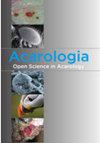摩洛哥蜥蜴寄生螨和蜱虫的新地点和寄主记录
IF 0.9
3区 农林科学
Q3 ENTOMOLOGY
引用次数: 0
摘要
本研究的目的是调查螨虫和蜱寄生在摩洛哥蜥蜴身上的关系及其决定因素。在自然生境中随机捕获18属8科27种1498只蜥蜴。总患病率为22.4%,平均强度为14.5 (95% CI: 12.2 ~ 16.8)。鉴定出蜱螨(螯角目)4科:蜱螨科、大蜱螨科、翼虫螨科和恙螨科,新增寄主记录11条,地理分布新数据。恙螨最多(17.2%),其次是翼虫科(4.1%)、伊蚊科(1.5%)和大螨科(0.4%)。其中,大翅虫的平均强度最高,为31.7(14.3 ~ 54.2),其次是翼虫科22.0(16.2 ~ 30.5),恙虫科12.7(10.9 ~ 14.8),伊蚊科1.7(1.3 ~ 2.2)。总共发现了9种寄生虫,并记录了3种蜥蜴的共同感染。依螨流行率和强度与海拔高度和寄主种类显著相关,而巨螨流行率和强度与寄主年龄和海拔高度相关。所有螨科的外寄生强度均与蜥蜴性别有关,雄螨比雌螨负重更重,而只有翼虫螨和恙螨的患病率与性别有关。季节对蜱螨和恙螨的侵害强度有重要影响。最后,寄主特征(种类、大小、年龄等级)和海拔高度是影响翼虫螨和恙螨侵染率和强度的决定因素。粘虫科和大翅虫科主要附着在寄主的腹侧,恙虫科和翼虫科主要附着在寄主身体的不同部位,聚集在皮肤褶皱处。这一最新信息将有助于建立生物多样性模型和预测人畜共患疾病暴发。本文章由计算机程序翻译,如有差异,请以英文原文为准。
New locality and host records of mites and ticks (Chelicerata: Acari) parasitizing lizards of Morocco
The aim of this study was to investigate the parasitic relationships of mites and ticks infesting lizards in Morocco and their determinant factors. A total of 1498 lizards representing 27 species, 8 families and 18 genera were randomly captured and examined in their natural habitats. The overall prevalence of ectoparasite infestation was 22.4%, with a mean intensity of 14.5 (95% CI: 12.2 – 16.8). Four families of Acari (Chelicerata) were identified: Ixodidae, Macronyssidae, Pterygosomatidae, and Trombiculidae, with eleven new host records and new data on geographical distributions. Trombiculid mites were the most prevalent (17.2%), followed by the Pterygosomatidae (4.1%), the Ixodidae (1.5%), and the Macronyssidae (0.4%). Nevertheless, Macronyssids showed the highest mean intensity 31.7 (14.3 – 54.2), followed by the Pterygosomatidae 22.0 (16.2 – 30.5), the Trombiculidae 12.7 (10.9 – 14.8), and the Ixodidae 1.7 (1.3 – 2.2). In total, nine species of parasites were found, and co-infestations were recorded on three lizard species. Ixodid prevalence and intensity were significantly related to altitude and host species, whereas Macronyssid prevalence and intensity were associated with host age and altitude. Ectoparasite intensity was associated with lizard sex for all mite families, with males carrying heavier loads than females, while prevalence was related to sex only for Pterygosomatid and Trombiculid mites. Season was important for Macronyssid and Trombiculid infestation intensity. Finally, host characteristics (species, size, age class), along with altitude, were determinant factors for infestation prevalence and intensities in Pterygosomatid and Trombiculid mites. The Ixodidae and Macronyssidae were mainly attached to the ventral side of hosts, whereas the Trombiculidae and Pterygosomatidae were attached to different parts of the host body with aggregations in skin folds. This updated information should prove useful for modeling biodiversity and predicting zoonotic disease outbreaks.
求助全文
通过发布文献求助,成功后即可免费获取论文全文。
去求助
来源期刊

Acarologia
ENTOMOLOGY-
CiteScore
2.00
自引率
18.20%
发文量
81
期刊介绍:
Acarologia is a free open-access journal. Please help us by submitting manuscripts in accordance with following instructions.
All manuscripts which do not conform to the instructions will be returned to authors without the benefit of review.
Acarologia publishes the results of original research on all aspects of Acarology.
The journal policy is that taxonomic descriptions should include several species within a same genus/family, when possible.
The editors reserve the right to refuse manuscripts when authors intentionally divide individual species descriptions of the same genus/family into distinct publications.
Single species descriptions should be clearly justified based on their scientific interest.
 求助内容:
求助内容: 应助结果提醒方式:
应助结果提醒方式:


